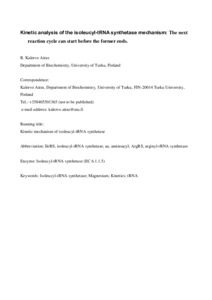Kinetic analysis of the isoleucyl-tRNA synthetase mechanism: the next reaction cycle can start before the previous one ends
R. Kalervo Airas
https://urn.fi/URN:NBN:fi-fe2021042718689
Tiivistelmä
Aminoacyl-tRNA synthetases join correct amino acids to their cognate tRNA at the start of the protein synthesis. Through the kinetic analysis, it is possible to estimate how their functional details correspond to the known structural features. Kinetic analysis of the isoleucyl-tRNA synthetase (IleRS) from Escherichia coli was accomplished. Sixteen different steady-state two-ligand experiments were statistically analysed simultaneously so that the same rate equations and same rate and dissociation constants applied to all experiments. The so-called rapid equilibrium segments procedure was used to derive the rate equations. The final best-fit mechanism included the normal activation and transfer steps, and reorganization of the steps between them and after the transfer step. In addition, the analysis strongly suggested an additional activation step, formation of a new isoleucyl-AMP before the isoleucyl-tRNA was freed from the enzyme. The removal of Ile-tRNA was possible without the formation of Ile-AMP if both isoleucine and ATP were bound to the E-Ile-tRNA complex, but this route covered only 11% of the total formation of Ile-tRNA. In addition to the Mg2+ in MgATP or MgPPi, only two tRNA-bound Mg2+ were required to explain the magnesium dependence in the best-fit mechanism. The first Mg2+ could be present in all steps before the second activation and was obligatory in the first reorganizing step and transfer step. The second Mg2+ was present only at the transfer step, whereas elsewhere it prevented the reaction, including the activation reactions. Chloride inhibited the IleRS reaction, while 100 mm KCl caused 50% inhibition if the ionic strength was kept constant with K-acetate. The  Kmapp (tRNA) value was increased from 0.057 to 1.37 μm when the KCl concentration was increased from 0 to 200 mm. The total rate equation helps to understand the reaction route and how the simultaneous presence of Ile-tRNA and Ile-AMP can cause new possibilities to proofreading mechanisms of this enzyme.
Kmapp (tRNA) value was increased from 0.057 to 1.37 μm when the KCl concentration was increased from 0 to 200 mm. The total rate equation helps to understand the reaction route and how the simultaneous presence of Ile-tRNA and Ile-AMP can cause new possibilities to proofreading mechanisms of this enzyme.
Kokoelmat
- Rinnakkaistallenteet [27094]
